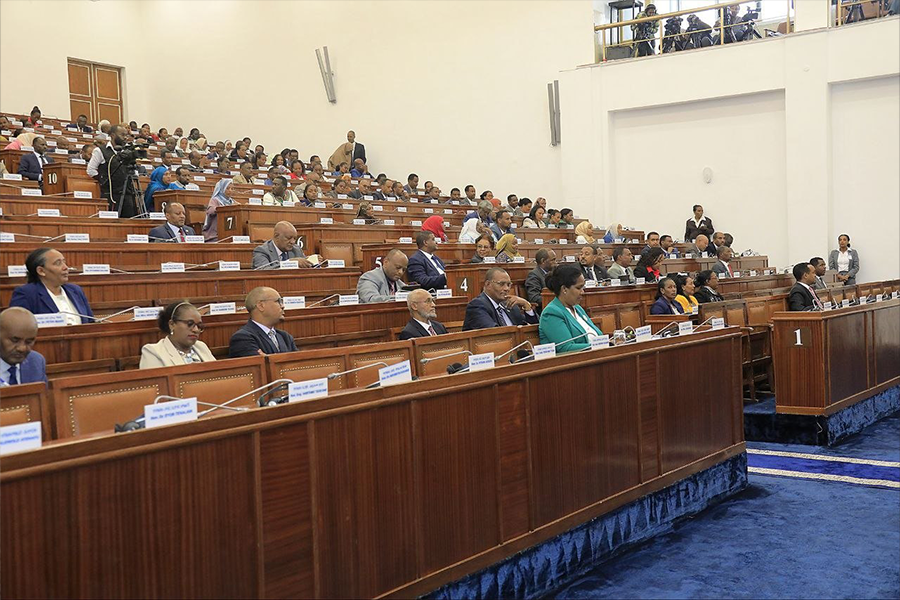
Habtamu Bogale is a farmer who takes a great sense of pride in knowing "every inch" of the thick highland forests of Keffa. It is hard to challenge, for he grew up in Keffa Zone, South Western Regional State, where he and his peers spent their youth watching parents grow coffee.
The legend of coffee is in Habtamu and his friends' favour. Their native land birthed the word "coffee", which first entered the English lexicon in 1582, from the Dutch Koffie. The Dutch got the word from the Turkish "Kahveh", who copied it from the Arabic "Qahwah". It was the Arab traders (perhaps slaves) who borrowed the word from Kaffa, earning the area the reputation as the "cradle of coffee." It is easier for Habtamu to relate to the legend of coffee; a goatherd over a millennium ago discovered the cherries after his animals chewed a few and began acting unnaturally active. The boy was tempted to share the goats' elation and tried a few of the bitter cherries himself.
The idiom that "legend remains victorious in spite of history" echoes in Keffa, one of the country's leading coffee-producing areas. The cherries are an indispensable source of income to thousands of households that depend on coffee to support their livelihoods. Habtamu's parents had a living growing the cash crop on more than 30hct of land. As an adult, he followed in their footsteps and began farming coffee on 10hct of his own.
Still, Habtamu was crestfallen to find productivity on his farm low. The quality of coffee he grows was also not up to par.
“I remember the fruitless efforts I put into those years,” the 47-year-old farmer reflects.
For centuries, farmers like Habtamu have harvested coffee cherries from their backyard and the surrounding forests in Keffa Zone. But, they could only sell their hard-earned crops to local traders for domestic consumption at low prices. An estimated 15 million people in Ethiopia depend on coffee farming and trade to make a living.
“I used to sell a kilogram of coffee for less than five Birr,” Habtamu recalled.
It was hard to give up easily, though. Habtamu, his wife, and their five children depend on the farm. Unfazed, he continued to search for options.
Four years ago, he found what he was looking for. The cooperative he is a member of began sourcing coffee from farmers in the area and processing the crop using new and uncommon methods experts describe as "honey-processed coffee." The red and ripe coffee cherries are picked and sorted before their skins and pulps are removed like other types of coffee, but mechanically. They are dried without washing off the sticky-sweet mucilage, hence honey-processed. The remaining amount of mucilage gives the coffee bean's colour and character.
Honey-processed beans are stored without water, with less fermentation occurring, and not as much of the sugar in the bean is converted to acid. The beans are dry-milled to remove the parchment layers, sorted, graded, bagged, and shipped.
More than 64,000 smallholder farmers in Keffa harvested 3,713qtl of coffee on 600hct of land during the last harvest season. It was part of the 250,000qtl of coffee harvested on 23,000hct in the Southern region last year. Keffa Zone was part of the Southern Regional State until last year, and before it was integrated into the newly-constituted South-Western Regional State through a plebiscite.
The southern regional state trails behind the Oromia Regional State, where farmers produced 2.2 million quintals of the cash crop on 240,000hct over the same period. The 5.8 million quintals produced countrywide placed Ethiopia as the fifth-largest coffee producer globally, following Brazil, Vietnam, Colombia and Indonesia. It exports around 35pc of the coffee harvested annually; approximately 2.5 million quintals shipped abroad last year, generating 854 million dollars. Export revenues have registered at nearly 750 million dollars thus far, a kilogram of coffee fetching 3.4 dollars on average.
Ethiopian coffee farmers receive a fraction of this value. Many blame the long supply chains and the heavy involvement of intermediaries.
Jema Haji (PhD) is an agricultural economist who lectured at Haromaya University for 35 years. He says higher market prices for speciality coffee do not necessarily mean that farmers are getting the income they deserve.
“Most farmers earn less than a cent a cup," said Jema.
The expert, who has researched the coffee market, observed that only a tiny proportion of Ethiopia’s beans are sold as exclusive, speciality coffees from a specific location.
“There is a need to expand initiatives that guarantee a better minimum price for the farmers," he said.
Farmers and suppliers transact near coffee farms, and in various markets, centres numbered 980. Last year, Habtamu supplied 50qtl of coffee to Michetie Cooperative at 25 Br a kilo (0.48 dollars in the exchange rate last week). He earned 125,000 Br, a tidy sum compared to what he used to make in the days when wholesalers were his only buyers.
This year, Habtamu and many farmers in his village supplied the same amount to the Cooperative; he saw his earnings shoot up 12pc to 140,000 Br as prices had increased by three Birr a kilo. The gains have been a relief for Habtamu and his family.
Unlike many other coffee farmers in Ethiopia, Habtamu and 350 of his peers in Keffa Zone directly sell the red forest coffee cherries they collect to a nearby market centre, where the cherries are processed, and the farmers are paid upfront. They no longer worry about storing and drying the cherries on top of earning better pay.
Established in 1999, Michetie Cooperative has 371 farmers as its members. It began to prepare coffee using the honey processing method in 2018. It contrasts the dry and washed processing methods farmers widely use across the country. Dry processing is the simplest and least expensive method, accounting for around 60pc of all processing.
With more procedures than the dry method, washed processing is widely used in places with sufficient freshwater supplies. The quality of coffee produced by this method is also superior to that of the dry process. Semi-washed processing is the other method gaining momentum in Ethiopia. Similar to washed processing, farmers remove the outer skin of the bean. However, the mucilage remains on the parchment until sun-dried and removed. Coffee processed through these three techniques account for almost all exports.
However, honey processing has been gaining popularity in Keffa and a few other places in Latin American countries such as Costa Rica, Brazil and Panama. Costa Rica, in particular, has popularised the method.
Last year, Michetie Cooperative exported 1,800kg of honey-processed coffee through the Kaffa Forest Coffee Farmers’ Cooperative Union.
The Oromia Regional State accounted for around 40pc of the 5.8 million quintals of coffee harvested last year.
"The Union enters into a contract based on the market price,” said Abebe Magnecho, the Union's general manager. “One kilo of [honey] coffee brings eight dollars.”
Attempts to ship another 2,400kg of coffee to Germany and Japan were unsuccessful due to the pandemic, according to Tegege Tadesse, general manager of the Cooperative. His cooperative is one of three under the Union that had been actively engaged in preparing honey-processed coffee last year. They earned close to 100,000 dollars each.
This raised farmers' earnings like Habtamu, who received 25,000 Br in dividends from Michetie Cooperative last year. Cooperatives distribute 70pc of their annual profits to farmers as dividends.
Abebe says with sales and a more reliable market, producers are motivated to produce higher volumes of this type of coffee. A little over 14tn of speciality coffee was exported over the first eight months of the year; a tiny fraction of the more than 200,000tn of speciality coffee was exported.
The global speciality coffee market was valued at 35.8 billion dollars in 2018, according to a report by Adroit Market Research, the US-based global business analytics and consulting company. Revenues are projected to grow at 13.3pc annually, and the value of this market is forecasted to reach 83.5 billion dollars in three years.
Although honey-processed coffee is a speciality and little-known among consumers, many coffee shops and roasters in Europe and North America are trying to carve a slice in this niche market. Happy Goat Coffee, a Canada-based roaster and retailer operating 10 outlets, is among the speciality roasters buying from the Union. Last year, the company bought 80qtl of honey-processed coffee.
The efforts have also garnered the attention of development agencies such as GIZ. The German cooperative agency has provided technical assistance to farmers organised under four cooperatives in the Keffa Zone, including the grading and certification of honey-processed coffee. The agency supplied farmers with equipment and provided training to promote the new product through sample cupping and access to international coffee events, according to Raffael Fondacci, project manager of GIZ’s Partnerships for Forests (P4F) project.
It is a project launched five years ago to encourage farmers to protect the forest through programs that can benefit them from the ecosystems. The first phase lasted three years after 1.82 million dollars was spent. The project includes the promotion of wild coffee.
Long before it became Ethiopia's major export commodity, coffee grew naturally in the dense forests of southern Ethiopia. Forest and semi-forest categories account for an estimated 45pc of total production, though much of the volume is still sold as commercial-grade coffee, earning low prices.
A kilo of certified wild coffee is sold for five dollars on the international market, 1.5 dollars higher than the average price for commercial coffee.
Despite enjoying high demand internationally in speciality coffee, the bulk of Ethiopian forest coffee is not certified, and the varieties are not specifically branded, which impedes exports and depresses revenues. Industry observers argue that creating a premium market for different and high-quality varieties of wild coffee can bolster the industry and play an essential role in the economy. GIZ's project was launched partly to address such crucial structural challenges, including low quality, absence of traceability and certification, and poor branding and marketing, according to Fondacci.
The efforts have provided better opportunities for farmers like Tamiru Tadesse, 41, a father of six.
Last year, Tamiru sold 1,113kg of wild coffee at 25 Br a kilo to Michetie Cooperative. He earned close to 28,000 Br. He sold more than double the volume at 28 Br a kilo this year, netting over 67,000 Br. He also received 5,000 Br in dividends from the Cooperative.
Last year, Michetie Cooperative supplied 592qtl of washed and 14,000qtl of unwashed wild coffee to the Keffa Forest Coffee Farmers’ Cooperative Union. Keffa is among the five unions exporting directly through the vertical integration model introduced three years ago by the Ethiopian Coffee & Tea Authority, allowing exporters to source coffee directly from suppliers and farmers.
Until recently, the model did not apply to honey-processed coffee, according to Molla Demisse, director of agro-processing at the Authority. Exporters received the nod to ship four types of certified coffee, including honey-processed coffee, last October, Molla disclosed.
“It was due to the growing interest," he told Fortune.
Teppi Coffee Producer Farmers’ Cooperatives Union is among those that have directly been exporting wild coffee. It has been exporting an average of 180qtl annually, according to Solomon Tilahun, general manager of Teppi.
Over the last two years, Keffa and Teppi unions produced 4,545tn and exported 3,672tn of certified forest coffee, fetching close to 20 million dollars.
The numbers are expected to grow with the vertical integration model. Though the Authority had been experimenting with it since 2017, vertical integration took off over the past year. Half of the 850 million dollars worth of coffee shipped abroad last year was sourced through the new model. Yet, a lack of technical assistance hinders farmers, cooperatives, and unions from exporting more. Raffael attributed farmers' lack of awareness has discouraged these cooperatives and unions from embracing the scheme.
“Initially, the plan was to introduce the honey-processed coffee to six unions,” he told Fortune. “Only two unions were willing to embrace the project.”
Still, the progress is encouraging. Income from honey-processed coffee has enabled Habtamu to employ intercropping to grow tea on two hectares adjacent to his coffee farm.
“I'm no longer engaged in ordinary farming,” said Habtamu.
PUBLISHED ON
Apr 22,2022 [ VOL
23 , NO
1147]

Fortune News | Sep 30,2023

Fortune News | Aug 11,2024

Fortune News | Feb 03,2024

In-Picture | Oct 13,2024

Fortune News | Jul 19,2025

Fortune News | Oct 18,2025

Featured | Oct 19,2019

Radar | Jan 07,2022

Radar | Jan 01,2024

Fortune News | May 21,2022

Dec 22 , 2024 . By TIZITA SHEWAFERAW
Charged with transforming colossal state-owned enterprises into modern and competitiv...

Aug 18 , 2024 . By AKSAH ITALO
Although predictable Yonas Zerihun's job in the ride-hailing service is not immune to...

Jul 28 , 2024 . By TIZITA SHEWAFERAW
Unhabitual, perhaps too many, Samuel Gebreyohannes, 38, used to occasionally enjoy a couple of beers at breakfast. However, he recently swit...

Jul 13 , 2024 . By AKSAH ITALO
Investors who rely on tractors, trucks, and field vehicles for commuting, transporting commodities, and f...

Oct 25 , 2025
The regulatory machinery is on overdrive. In only two years, no fewer than 35 new pro...

Oct 18 , 2025
The political establishment, notably the ruling party and its top brass, has become p...

Oct 11 , 2025
Ladislas Farago, a roving Associated Press (AP) correspondent, arrived in Ethiopia in...

Oct 4 , 2025
Eyob Tekalegn (PhD) had been in the Governor's chair for only weeks when, on Septembe...